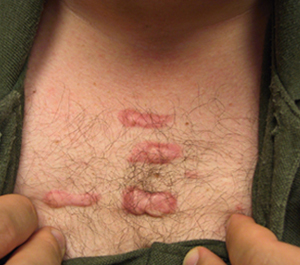
1. What is a keloid?
Keloid is a type of scar that is reddish, firm and rubbery. It is benign and noncancerous.
Keloids can develop spanteously or as a result of acne, scratching, trauma or after surgery. They are more common in some sites such as central chest, the back and shoulders and the ear lobes.
2. Are hypertrophic scars different from keloids?
Keloids should not be confused with hypertrophic scars, which are raised scars that do not grow beyond the boundaries of the original wound. Keloids expand in claw-like growths over normal skin.
3. How do you treat keloids?
There are different treatment options available for keloids, however no treatment for keloids is considered to be 100% effective.
-
Silicon sheets / Silicon gel application: It is safe and effective in reducing scars. The earlier the initiation of treatment, the better the prognosis.
-
Steroid injections: Steroid injections into the keloids help to reduce the thickness and itching in the keloids scars. A series of 3-4 injections with triamcinolone acetonide are given every 3-4 weeks. The fibrosis reduces which is evident in the form of softness of the lesion, reduction of size and flattening.
-
Cryosurgery: Cryosurgery is an excellent treatment for keloids which are small and multiple on lightly pigmented skin. It is often combined with monthly cortisone injections. It freezes the skin and causes sludging of the circulation beneath, effectively creating an area of localized frostbite.
-
Surgery: Surgery is done only for depalking the keloids and this will be followed with combination of other modalaties of treatment however regular follow up would be required to prevent recurrence.


